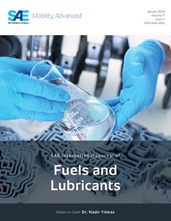Due to the single fuel concept implemented by the US military, the soot production of diesel engines fueled with JP-8 has important implications for military vehicle visual signature and survivability. This work compares in-cylinder soot formation and oxidation of JP-8 and ULSD in a small-bore, optical diesel engine. Experimental engine-out soot emission measurements are compared to crank-angle resolved two-color measurements of soot temperature and optical thickness, KL. A 3-D chemical kinetic-coupled CFD model with line of sight integration is employed in order to investigate the soot distribution in a 2-D projection associated with the imaging plane, as well as to aid in interpreting the third dimension along the optical depth which is not available within the experimental work. The study also examines the effect of volatility on soot emission characteristics by CFD simulation.
With the same injection pressure and timing for both fuels considered, heat release analysis shows JP-8 has more energy release than ULSD, however two color measurements indicate JP-8 produces less in-cylinder soot throughout the cycle as well as lower engine out measurements compared to ULSD. Furthermore, JP-8 is found to have a lower soot temperature and less high temperature areas than ULSD. A line of sight integration technique is applied to the CFD (Reaction Design FORTE) output to compare the simulation results with experimental high speed images. The model has good agreement with the experimental results, as does the predicted soot temperature and KL factor with the two color experimental measurements. However, interpretation of the two-color line of sight images obtained from the CFD simulation indicated that the measurement of the KL factor will be affected by the amount of radiation intensity available to a camera characterized by a finite dynamic range. Finally, the effect of fuel volatility is investigated using the CFD model by varying fuel evaporation properties. It is observed that the high volatility fuels, such as JP-8, exhibit lower engine out soot emissions due to better fuel mixing and increased local equivalence ratio homogeneity.
